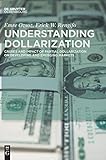Understanding Dollarization : Causes and Impact of Partial Dollarization on Developing and Emerging Markets / Emre Ozsoz, Erick W. Rengifo.
Material type: TextPublisher: München ; Wien : De Gruyter Oldenbourg, [2016]Copyright date: ©2016Description: 1 online resource (X, 129 p.)Content type:
TextPublisher: München ; Wien : De Gruyter Oldenbourg, [2016]Copyright date: ©2016Description: 1 online resource (X, 129 p.)Content type: - 9783110442182
- 9783110434033
- 9783110437027
- 332.491724 22/ger
- HG3877
- online - DeGruyter
| Item type | Current library | Call number | URL | Status | Notes | Barcode | |
|---|---|---|---|---|---|---|---|
 eBook
eBook
|
Biblioteca "Angelicum" Pont. Univ. S.Tommaso d'Aquino Nuvola online | online - DeGruyter (Browse shelf(Opens below)) | Online access | Not for loan (Accesso limitato) | Accesso per gli utenti autorizzati / Access for authorized users | (dgr)9783110437027 |
Frontmatter -- Foreword -- Contents -- 1. A Primer on Dollarization -- 2. Pros and Cons of Dollarization -- 3. What Causes Dollarization? -- 4. The Impact of Dollarization on Banking Systems -- 5. Dollarization, Financial Deepening and Financial Inclusion -- 6. Policy Interventions in Dollarized Economies -- 7. Conclusions -- References -- Index
restricted access online access with authorization star
http://purl.org/coar/access_right/c_16ec
A very commonly observed phenomenon in developing and emerging market economies is the use of another country’s currency (US dollar or other) in lieu or in addition to the local currency. Governments in these countries have been encouraging dollarization for years by allowing their citizens to save and borrow from local banks in foreign currency, posing risks to the health and stability of their banking systems.
A very commonly observed phenomenon in developing and emerging market economies is the use of another country’s currency (whether the US dollar or another currency) in lieu or in addition to the local currency. The most common type of this financial phenomenon is partial (de facto) dollarization where foreign currencies are used side by side with local currency for saving and borrowing purposes in addition to serving as medium of exchange. Governments in these countries have been encouraging dollarization for years by allowing their citizens to save and borrow from local banks in foreign currency. Yet the existence of multiple currencies on banks' balance sheets on both the asset and liability side poses risks to the health and stability of the banking system. This book evaluates the practical aspects of partial dollarization in countries such as Turkey, South Korea, Peru, and Cambodia among others. Starting with the origins of the phenomenon, the impact on banking systems and financial depth of the credit markets are discussed along with risks to the banking systems. Challenges faced by Central Banks and banking regulators are evaluated using recent country studies.
Mode of access: Internet via World Wide Web.
In English.
Description based on online resource; title from PDF title page (publisher's Web site, viewed 30. Aug 2021)


